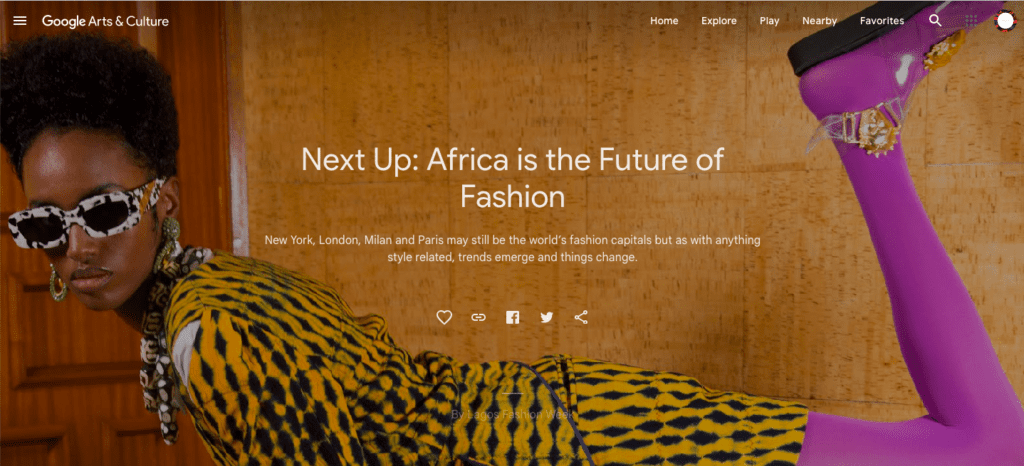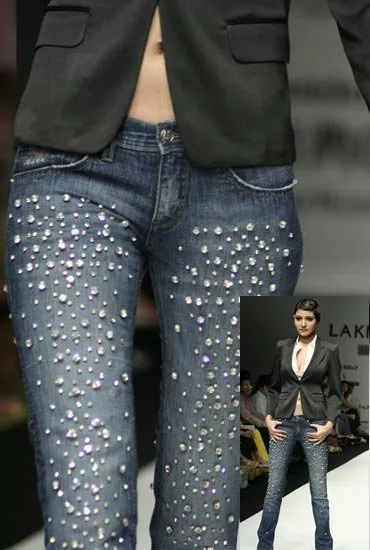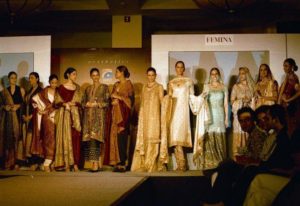The future of Pakistan’s fashion and textile industry once depicted in this image (above) from the past. Certainly, the now leading Bollywood super star Anushka Sharma was walking the ramp of the Pakistan Fashion Week Show in 2007 at Lakme Fashion Week.
As Project Director, this writer presented and negotiated deals besides marketing the launch of Pakistan Fashion Week Internationally with IMG Asia Pacific. Including co-producing the (inaugural) PFW Show at the prestigious Lakme Fashion Week in Mumbai 2007. Hence, starting the (official) journey of Pakistan Fashion & Textile Industry in the international circuit of fashion weeks and the business of fashion.
Similarly, the future (still) lies in embracing a vision of innovation backed by sustainability. Over the years, this industry has witnessed significant growth, evolving from traditional craftsmanship to embracing modern technology and consumer trends.
Relevance
We know that Pakistan has the infrastructure to meet international orders if required. This was evident during the pandemic, when global supply chains were affected. As a result, orders were shifted to Pakistan from Bangladesh and even China in order to meet demand. During this time shipments grew at a faster pace than even India. However, this was a crisis management solution for the global fashion market. For example, brands like Hugo Boss. In the same vein, it offers insights and opportunities for Pakistan to learn and adapt.
Pakistan’s fashion and textile industry has been a significant contributor to the country’s economy, employing millions of people and earning valuable foreign exchange. Textile and clothing exports account for over 61% of Pakistan’s total exports, making it a crucial sector for foreign exchange earnings. However, it is facing daunting challenges which must be addressed first. Please read the blog Pakistan’s Textile Exports:Challenges and Road To Recovery.
In this blog, we will explore the future prospects and past trends to understand the trajectory it is likely to take.
Fashion Weeks Boosting Apparel Trade
Fashion weeks around the world play a crucial role in boosting trade and business in the apparel and textile industry. These events provide a platform for designers, brands, manufacturers, and buyers to showcase their latest collections, establish connections, and drive economic growth. Here are some ways in which fashion weeks contribute to the trade and business of apparel and textiles, supported by examples and data:
- Promotion and Exposure: Fashion weeks attract significant media coverage, both traditional and digital, generating widespread exposure for participating designers and brands. This exposure increases brand visibility and helps them reach a global audience. For instance, New York Fashion Week generates approximately $887 million in direct visitor spending and attracts around 230,000 attendees annually, including buyers, retailers, and journalists.
- Business Opportunities: Fashion weeks serve as a platform for designers and brands to connect with potential buyers and secure orders. Buyers from retail stores, boutiques, and online platforms attend these events to discover new talent, identify trends, and make purchasing decisions. According to a study conducted by the British Fashion Council, London Fashion Week contributes £269 million ($362 million) in direct orders each season.
- Trade Events and Exhibitions: Fashion weeks often include trade events and exhibitions where manufacturers, suppliers, and textile companies showcase their products and services. These events facilitate business-to-business interactions, fostering collaborations and partnerships. For instance, Texworld Paris, a trade fair held alongside Paris Fashion Week, hosts over 1,000 exhibitors and attracts thousands of international visitors, promoting trade and business in the textile industry.
- Economic Impact: Fashion weeks have a significant economic impact on the host cities and countries. They attract tourists, boost hospitality and retail sectors, and create employment opportunities. Milan Fashion Week contributes approximately €1.8 billion ($2.1 billion) to the local economy annually, according to a study by Bocconi University and the Camera Nazionale della Moda Italiana.
- Trendsetting and Innovation: Fashion weeks set trends and influence the direction of the fashion industry. Designers and brands showcase innovative designs, materials, and techniques, inspiring the development of new products and driving demand in the apparel and textile sectors. For example, Copenhagen Fashion Week has become a leading platform for sustainable fashion, promoting eco-friendly practices and materials.
- Networking and Industry Insights: Fashion weeks bring together professionals from different sectors of the industry, including designers, buyers, manufacturers, and influencers. This networking opportunity allows for the exchange of ideas, collaborations, and industry insights. Fashion weeks often host seminars, panel discussions, and workshops that provide valuable knowledge and foster business growth.
These examples demonstrate how fashion weeks worldwide contribute to the trade and business of apparel and textiles. By providing a platform for promotion, business opportunities, trade events, and networking, these events drive economic growth, innovation, and international collaborations in the industry.
A journey also taken by this writer Asim Qureshi by launching Pakistan Fashion Week with IMG gloabl circuit internationally. Read on below link.
Pakistani brands can expand their global presence and enhance competitiveness as follows:
Diversification of Product Range
Pakistan’s fashion and textile industry has traditionally relied on producing home textile to maximize exports. To secure a sustainable future, it is essential to focus on diversifying i.e. value addition.
𝐃𝐢𝐯𝐞𝐫𝐬𝐢𝐟𝐲𝐢𝐧𝐠 𝐩𝐫𝐨𝐝𝐮𝐜𝐭 𝐫𝐚𝐧𝐠𝐞 𝐰𝐢𝐭𝐡 𝐭𝐡𝐞 𝐡𝐞𝐥𝐩 𝐨𝐟 𝐞𝐱𝐩𝐞𝐫𝐭𝐬 𝐢𝐧 𝐫𝐞𝐬𝐞𝐚𝐫𝐜𝐡 𝐚𝐧𝐝 𝐝𝐞𝐯𝐞𝐥𝐨𝐩𝐦𝐞𝐧𝐭 𝐚𝐬 𝐰𝐞𝐥𝐥 𝐚𝐬 𝐝𝐞𝐬𝐢𝐠𝐧. 𝕋𝕙𝕖 𝕚𝕟𝕕𝕦𝕤𝕥𝕣𝕪 𝕤𝕙𝕠𝕦𝕝𝕕 𝕖𝕩𝕡𝕝𝕠𝕣𝕖 𝕠𝕡𝕡𝕠𝕣𝕥𝕦𝕟𝕚𝕥𝕚𝕖𝕤 𝕥𝕠 𝕖𝕩𝕡𝕒𝕟𝕕 𝕚𝕟𝕥𝕠 𝕔𝕒𝕥𝕖𝕘𝕠𝕣𝕚𝕖𝕤 𝕤𝕦𝕔𝕙 𝕒𝕤 , 𝕒𝕔𝕥𝕚𝕧𝕖 𝕨𝕖𝕒𝕣, 𝕒𝕔𝕔𝕖𝕤𝕤𝕠𝕣𝕚𝕖𝕤, 𝕞𝕠𝕕𝕖𝕤𝕥 𝕗𝕒𝕤𝕙𝕚𝕠𝕟, 𝕗𝕠𝕠𝕥𝕨𝕖𝕒𝕣 𝕒𝕟𝕕 𝕡𝕠𝕤𝕤𝕚𝕓𝕝𝕪 𝕞𝕠𝕣𝕖 𝕚𝕟 𝕥𝕙𝕖 𝕨𝕠𝕣𝕝𝕕 𝕠𝕗 𝕗𝕒𝕤𝕙𝕚𝕠𝕟.
Collaborations with designer brands can help Pakistani Fashion gain global recognition in order to reach new audiences.Forging strategic partnerships with international buyers and retailers. By leveraging trade agreements, exploring new markets, and participating in international fashion events.
International Trade and Global Partnerships
The current decline in exports can be partially attributed to reduced demand from key export destinations such as the United States, the United Kingdom, the Netherlands, Spain, and Germany.In my observation the global Indian buyer and the African markets are the best bet for strategically marketed Pakistani fashion and textile exports.
ᴛʜᴇ ɢʟᴏʙᴀʟ ɪɴᴅɪᴀɴ ɪꜱ ᴀʟʀᴇᴀᴅʏ ᴀ ʟᴇᴀᴅɪɴɢ (ɪɴꜰᴏʀᴍᴀʟ ʙᴜʏᴇʀ) ᴀᴛ ᴘᴀᴋɪꜱᴛᴀɴɪ ꜰᴀꜱʜɪᴏɴ ᴅᴇꜱɪɢɴᴇʀ ᴇxʜɪʙɪᴛɪᴏɴꜱ ʜᴇʟᴅ ɪɴ ᴛʜᴇ ʟᴀꜱᴛ 2 ᴅᴇᴄᴀᴅᴇꜱ. ʙᴇ ɪᴛ ɪɴᴛ ᴛʜᴇ ᴜꜱᴀ,ᴜᴋ,ᴄᴀɴᴀᴅᴀ ᴜᴀᴇ . ᴀʟᴍᴏꜱᴛ 2 ᴏᴜᴛ ᴏꜰ ᴇᴠᴇʀʏ 3 ɪꜱ ᴀɴ ɪɴᴅɪᴀɴ ʙᴜʏᴇʀ.
ᴀꜰʀɪᴄᴀ ( ꜰʀᴏᴍ ᴄᴀɪʀᴏ ᴛᴏ ᴄᴀᴘᴇᴛᴏᴡɴ) ʜᴀꜱ ᴏɴᴇ ᴏꜰ ᴛʜᴇ ꜰᴀꜱᴛᴇꜱᴛ ɢʀᴏᴡɪɴɢ ꜰᴀꜱʜɪᴏɴ ᴍᴀʀᴋᴇᴛ ᴀɴᴅ ᴛʜᴇɪʀ ᴇᴄᴏɴᴏᴍɪᴇꜱ ᴄᴏɴᴛɪɴᴜᴇ ᴛᴏ ɢʀᴏᴡ.ᴛʜᴇɪʀ ʏᴏᴜɴɢ ᴘᴏᴘᴜʟᴀᴛɪᴏɴ ɪꜱ ꜰᴀꜱʜɪᴏɴᴀʙʟʏ ᴀᴡᴀʀᴇ ᴀɴᴅ ᴡɪʟʟɪɴɢ ᴛᴏ ᴛʀʏ ᴍᴏʀᴇ. ᴍᴀɴʏ ɪɴᴛᴇʀɴᴀᴛɪᴏɴᴀʟ ʙʀᴀɴᴅꜱ ʜᴀᴠᴇ ʀᴇᴄᴏɢɴɪᴢᴇᴅ ᴛʜɪꜱ ʀᴇᴀʟɪᴛʏ ᴀɴᴅ ᴍᴏᴠᴇᴅ ɪɴ
ᴀꜱ ᴇᴀʀʟʏ ᴀᴅᴀᴘᴛᴇʀꜱ.
CLICK TO READ MORE ON AFRICA IS THE FUTURE OF FASHION

Sustainability and Ethical Practices
As global awareness of environmental issues and fair labor practices increases, sustainability and ethical considerations are becoming crucial. Globally for the fashion and textile industry.
Pakistan has a rich heritage of craftsmanship and artisanal skills. That can be leveraged to create sustainable fashion products. By adopting eco-friendly manufacturing processes. Using organic materials, and ensuring fair wages and working conditions.
Pakistan can position itself as a responsible player in the global fashion market.
Skill Development and Education
To meet the demands of the evolving fashion industry.Pakistan must invest in latest skill development vocational trainings. By providing current market training programs and establishing collaborations between educational institutions and industry professionals. The country can ensure a skilled workforce that is equipped with the latest techniques and trends. This will not only elevate the quality of products but also foster innovation and creativity within the industry.
Technological Advancements
To remain competitive in the global market, the fashion and textile industry in Pakistan must embrace technological advancements. Automation, artificial intelligence, and machine learning are reshaping various stages of the production process, from design and pattern making to cutting and stitching. Incorporating these technologies will enhance productivity, reduce costs, and enable faster product development. Moreover, technology transfer must be a top priority for Pakistan’s Fashion and Textile Industry.
E-commerce and Digitalization
The rise of e-commerce has transformed the way consumers shop for fashion. Pakistan’s fashion and textile industry must adapt to this changing landscape.
By developing robust e-commerce platforms and efficient logistics networks coupled with secure payment gateways. Barring a few, the industry as a whole is not operating at an optimal level of sales on the eCommerce side of things. Both locally and internationally.
The convenience of online shopping, , can significantly boost sales and create new avenues for growth. Speaking of international markets the likes of the USA, UK, Canada and the UAE can be very lucrative. However, this is dependent on the logistics, custom regulations and currency conversion rates.
Growing (Local) Consumer Market
Pakistan boasts a large and rapidly growing population. With a rising middle -upper class and increased (undocumented) purchasing power . Which also explains the recent innovation in retail store designs and experimental stores. Making shopping more immersive and fun for the new age Pakistani consumer.

˜”°• Above 30% YOY Retail Sales Growth for some leading Fashion Brands is a reality which cannot be ignored.
Eid SALES (Cash) should be an eye opener for industry enthusiasts. In spite the prevailing economic conditions and inflation, EXTRA (sales ) Counters were seen managing the footfall at leading fashion stores.
Therefore, revitalizing the belief in (branded) Fashion at home.As more people seek stylish clothing options in a larger than life environment.•°*”˜
This market shift presents a promising opportunity for the home grown fashion brands. As a result, domestic demand for fashion will continue to rise, driving growth domestically.
Conclusion
Firstly, by incorporating sustainable practices, diversifying product ranges, and establishing global partnerships, Pakistan can position itself as a competitive player in the international fashion market.
Secondly, With a skilled workforce and a commitment to quality, the industry has the potential to contribute significantly to the country’s economic development while preserving its rich cultural heritage.
In the same vein. With a growing (local) consumer market, technological advancements, and a focus on e-commerce and digitalization, the industry can tap into new opportunities for growth.
To sum up, the future can be promising, provided it embraces innovation, sustainability, and global trends.
Looking forward to your Feedback in Comments | For inquiries, please contact us on starringbrands@asimqureshi.com
Furthermore, (Below) about my journey of launching Pakistan Fashion Week Internationally
https://www.asimqureshi.com/inspiring-pakistan-and-india-to-do-it
- The Strategic Use of Entertainment in Nation-Building - August 23, 2024
- The Future of Pakistan:Realizing Potential, Upholding Human Rights - August 14, 2023
- The Future of Pakistan’s Fashion and Textile Industry - July 7, 2023



Excellent thought process simply explained.Based on your experience.You have correctly pointed out all these steps for Pakistan’s Fashion Brands to make a mark especially here in Africa and parts of Europe as you say Pakistan has a rich heritage of craftsmanship and artisanal skills. That can be leveraged to create sustainable fashion products. By adopting eco-friendly manufacturing processes. Using organic materials, and ensuring fair wages and working conditions.
Pakistani fashion has considerable demand among indian buyers I second that having attended many exhibitions over the years here in Dubai. They need to market themselves strongly. Good to know you have previously taken the lead in this regard.
Brilliant! Once again. Branding fashion is the way forward as you have in the past as well.
Yes I agree with you although being a Pakistani American it does get a little embarrassing to see our Indian American friends buying more of Pakistani designers at such exhibitions.
Hey I think the way forward is a long road but the strategy should be as you also rightly mention “Pakistan has a rich heritage of craftsmanship and artisanal skills. That can be leveraged to create sustainable fashion products. By adopting eco-friendly manufacturing processes.” Good Luck.
Well Done Asim Qureshi Sb, you are a good man who can do more for Pakistan Fashion & Textile Industry especially marketing internationally and help create new markets with your valuable and unique experience.
Greetings from Miami! Good Read your experience is valuable. please share more on your story of launching Pakistan Fashion Week
Good Vibes Asim ! Couldn’t agree more
Sustainability and ethics are a challenge in the world of fashion everywhere but it will prevail eventually.Keep promoting . Good Luck and Good Reads.
Game Changer #mindset from a #gamechanger whose done it before
#goodreads Asim Qureshi 👍
You’re #thoughts and experience about #africanfashion as a global consumer market along with (global) #indian as an underutilized market for #pakistanifashion is worth pursing as a #strategy.
[…] sustainable agricultural practices can not only boost food security but also drive economic growth by exporting high-quality produce. Additionally, the country’s mineral wealth, including coal, natural gas, and […]
[…] The Future of Pakistan’s Fashion and Textile Industry […]